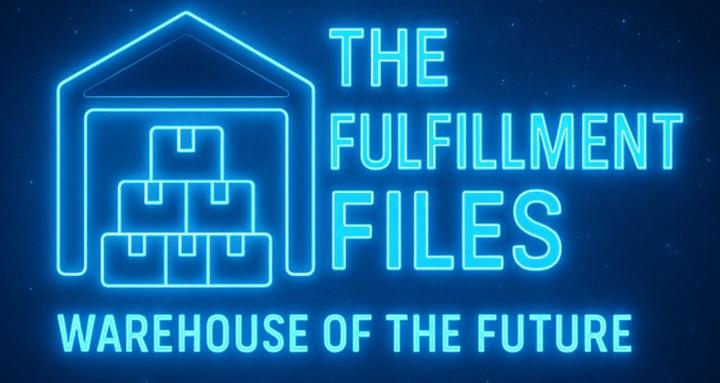
Write something
Pinned
Community Guidelines
📢 Welcome to The Fulfillment Files Community! This is the hub for fulfillment pros, vendors, and visionaries to share ideas, solve pain points, and build the DC of tomorrow. Whether you’re optimizing pick paths or dreaming up AI-driven warehouses, you’re in the right place. Let’s keep this community thriving with these guidelines: 1. Be Respectful: Share insights, not shade. We’re here to lift each other up, even when we disagree. 2. Stay On-Topic: Focus on warehouse ops, fulfillment, and future-ready solutions (AI, IoT, lean practices, etc.). Off-topic posts may be removed. 3. No Hard Sells: Promote your expertise through value (e.g., answering questions), not spammy pitches. Vendor intros are cool in the Welcome Thread. (Our hope is to hold monthly live vendor talks and case study break downs where you can highlight the potential of your company) 4. Ask & Share: Got a question? Post it! Have a hack? Share it! This community grows when we all contribute. 5. Keep It Professional: No NSFW content, politics, or unrelated rants. Let’s keep the vibe focused and inclusive. 6. 💡 Pro Tip: Use our hashtags (#AskAnOperator, #Q4Prep, #FulfillmentFuture) to join the conversation and get noticed. Questions? DM the mods or comment below. Let’s make this the go-to space for fulfillment innovation! 🚚 7. Introduce yourself (One GIF + One Pain-Point) , we would love to hear from you and your vibe! This is a place where we are removing industry barriers to make customers around the world have better experiences!
0
0
IoT Introduction
Let me know your thoughts around IoT and the gaps still in the industry around it! What’s IoT & Why It Matters for Fulfillment IoT connects devices (sensors, scanners, machines) to the internet to collect and share data in real-time. For warehouses, IoT can: Boost efficiency: Track inventory instantly. Cut costs: Spot issues like equipment downtime early. Improve accuracy: Reduce picking errors. Add value: Deliver faster, happier customers. Example: A $50 IoT sensor on a conveyor belt can alert you when it’s jammed, saving hours of downtime. Getting Started with IoT (Low-Tech Friendly) No need for a tech overhaul! Here’s an executable plan: Start Small: Buy affordable IoT sensors (e.g., RFID tags, temperature monitors). Example: Use Bluetooth trackers for high-value inventory. Focus on Pain Points: Struggling with misplaced pallets? Use IoT GPS tags. High energy bills? Smart plugs monitor power usage. Use Plug-and-Play Tools: Platforms like Tuya or AWS IoT offer user-friendly dashboards. No coding needed—just connect and monitor! Train Your Team: Run a 1-hour workshop to show staff how to read IoT alerts. Keep it simple: “Red light = check machine.” Measure ROI: Track metrics like order accuracy or downtime reduction. Example: A small IoT setup can save 5-10 hours/week in manual checks. Affordable: Start with a $100-200 pilot project. Scalable: Add more devices as you grow. Competitive Edge: Real-time data = faster decisions, happier clients. Future-Proof: IoT preps you for automation down the road. Real-World Win: A small 3PL in Ohio used IoT temp sensors to ensure cold-chain compliance, winning a $50K contract with a pharma client.
0
0
Real Time Shorts (or misses) by SKU Deep Dive SQL
SELECT p.item_id, i.item_name AS item_description, SUM(p.planned_qty) AS planned_quantity, SUM(p.picked_qty) AS picked_quantity, SUM(p.shipped_qty) AS shipped_quantity, SUM(CASE WHEN p.status = 'SHORTED' THEN p.planned_qty ELSE 0 END) AS shorted_quantity FROM warehouse.pick_details p LEFT JOIN warehouse.item_catalog i ON i.warehouse_id = p.warehouse_id AND i.item_id = p.item_id WHERE CAST(p.created_at AS DATE) >= '2025-06-08' -- since Sunday AND p.item_id IN ('04637336') GROUP BY p.item_id, i.item_name ORDER BY p.item_id;
0
0
Basic Variable Cost Per Unit By Order
SELECT o.order_id, o.order_date, c.client_name, o.channel, COUNT(oi.sku) AS sku_count, SUM(oi.quantity) AS total_units, SUM(oi.item_cost + oi.labor_cost + oi.packaging_cost + oi.carrier_cost) AS total_cost, ROUND(SUM(oi.item_cost + oi.labor_cost + oi.packaging_cost + oi.carrier_cost) / SUM(oi.quantity), 2) AS cpu, CASE WHEN o.order_date BETWEEN '2024-11-01' AND '2025-01-15' THEN 'Peak' ELSE 'Off-Peak' END AS season FROM orders o JOIN order_items oi ON o.order_id = oi.order_id JOIN clients c ON o.client_id = c.client_id GROUP BY o.order_id, o.order_date, c.client_name, o.channel ORDER BY cpu DESC;
0
0
VCPU Help
When you look at VCPU, what are you GO-TO triggers and check offs to make sure you are not eroding margins? How have you optimized it?
1-18 of 18
powered by

skool.com/the-fulfillment-files-2761
Unlock fulfillment strategies that top warehouses use and get access to hidden methods that slash costs, boost throughput, and deliver results—fast.
Suggested communities
Powered by
